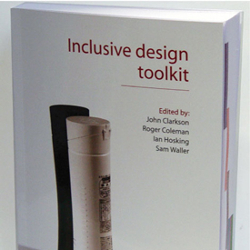To coincide with World Usability Day, researchers in the Department's Engineering Design Centre (EDC) are announcing the "Inclusive Design Toolkit". This is a new guide which aims to show companies how their products could be improved to appeal to the widest possible range of people.

As well as guidance covering all stages of the design process, the toolkit - which comprises a book and web resource - has interactive features that simulate impairments and generate graphs to show how many people would be unable to use a product because of its capability demand.
By 2020, more than half the adult population will be over 50 years old. People's capabilities reduce as age increases - be it through medical conditions, or as a result of deteriorating eyesight and reduced grip strength.


These physical limitations may put them off certain poorly-designed products, even though people in older age groups conversely often have the highest disposable income, having paid off their mortgages and climbed the career ladder. They also tend to have the most free time. As a result there is a business case, as well as a strong moral argument, for designing products that make appropriate demands on the user.
"We can all cite examples of products that are difficult or frustrating to use," project leader John Clarkson said. "For example, the average purchaser of a sports car is aged 55, but many models put off older buyers because they are extraordinarily difficult to get into and out of. By applying inclusive design principles, involving users in the design process, and considering the needs of people with reduced capabilities, products can be made more usable, useful and desirable."
The toolkit features numerous examples of how poorly-designed products become especially difficult to use for those with reduced capability in seven different areas, namely: vision, hearing, thinking, communication, locomotion, reach and stretch, and dexterity.
The inclusive design toolkit is now available to buy as a book providing tools and guidance so that organisations and designers can produce better products that are accessible to the widest possible range of people. The guidance ranges from corporate level strategy to project level advice, and the tools include graphs that estimate the number of people who would be unable to use a product, because of its capability demand. The book contains 350 pages with 280 full colour images, costs £30 + postage, and can be purchased through the inclusive design toolkit website.
The same content is freely available at www.inclusivedesigntoolkit.com the website also includes interactive resources such as visual impairment simulators and an exclusion calculator. Users can sample how a normal public address system, replayed through the hearing loss simulator, suddenly becomes muffled to the point where it can barely be heard at all. The visual simulator shows how common impairments like cataracts, colour blindness or glaucoma can make everyday activities like buying a train ticket or using a toaster near to impossible. It also demonstrates how simple improvements to the layout and contrast of these devices could make them easier to use for all.
The inclusive design toolkit was commissioned by BT, and constructed by the Department's Engineering Design Centre (EDC), together with contributions from Sagentia and the Royal College of Art, Helen Hamlyn Centre. The guidance and resources contained within the toolkit reflect the outcome from i~design projects, an on-going collaborative research programme on inclusive design, of which the EDC is a research partner. i~design is funded by the Engineering and Physical Sciences Research Council. Please see www-edc.eng.cam.ac.uk/books/ for details of other inclusive design books available through the Engineering Design Centre.
Further development of the toolkit over the coming year will focus on customising the toolkit so that it integrates seamlessly with an undergraduate degree project on inclusive design, and developing pro-formas to assist the use of the inclusive design process within industry. Please contact Sam Waller sdw32@cam.ac.uk if you would be interested in collaborating on this development.

